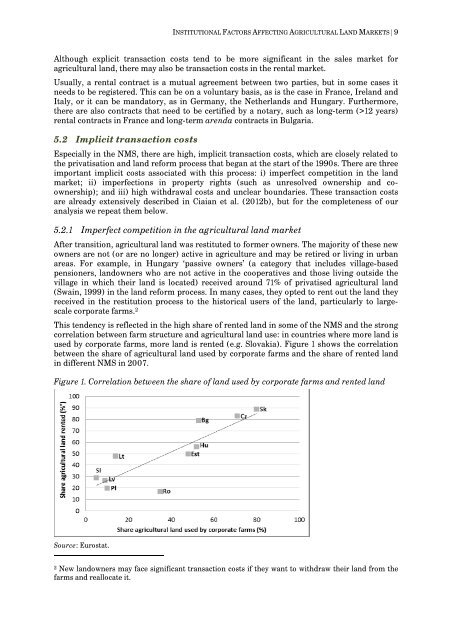Institutional Factors Affecting Agricultural Land Markets
Institutional Factors Affecting Agricultural Land Markets
Institutional Factors Affecting Agricultural Land Markets
Create successful ePaper yourself
Turn your PDF publications into a flip-book with our unique Google optimized e-Paper software.
INSTITUTIONAL FACTORS AFFECTING AGRICULTURAL LAND MARKETS | 9<br />
Although explicit transaction costs tend to be more significant in the sales market for<br />
agricultural land, there may also be transaction costs in the rental market.<br />
Usually, a rental contract is a mutual agreement between two parties, but in some cases it<br />
needs to be registered. This can be on a voluntary basis, as is the case in France, Ireland and<br />
Italy, or it can be mandatory, as in Germany, the Netherlands and Hungary. Furthermore,<br />
there are also contracts that need to be certified by a notary, such as long-term (>12 years)<br />
rental contracts in France and long-term arenda contracts in Bulgaria.<br />
5.2 Implicit transaction costs<br />
Especially in the NMS, there are high, implicit transaction costs, which are closely related to<br />
the privatisation and land reform process that began at the start of the 1990s. There are three<br />
important implicit costs associated with this process: i) imperfect competition in the land<br />
market; ii) imperfections in property rights (such as unresolved ownership and coownership);<br />
and iii) high withdrawal costs and unclear boundaries. These transaction costs<br />
are already extensively described in Ciaian et al. (2012b), but for the completeness of our<br />
analysis we repeat them below.<br />
5.2.1 Imperfect competition in the agricultural land market<br />
After transition, agricultural land was restituted to former owners. The majority of these new<br />
owners are not (or are no longer) active in agriculture and may be retired or living in urban<br />
areas. For example, in Hungary ‘passive owners’ (a category that includes village-based<br />
pensioners, landowners who are not active in the cooperatives and those living outside the<br />
village in which their land is located) received around 71% of privatised agricultural land<br />
(Swain, 1999) in the land reform process. In many cases, they opted to rent out the land they<br />
received in the restitution process to the historical users of the land, particularly to largescale<br />
corporate farms. 2<br />
This tendency is reflected in the high share of rented land in some of the NMS and the strong<br />
correlation between farm structure and agricultural land use: in countries where more land is<br />
used by corporate farms, more land is rented (e.g. Slovakia). Figure 1 shows the correlation<br />
between the share of agricultural land used by corporate farms and the share of rented land<br />
in different NMS in 2007.<br />
Figure 1. Correlation between the share of land used by corporate farms and rented land<br />
Source: Eurostat.<br />
2 New landowners may face significant transaction costs if they want to withdraw their land from the<br />
farms and reallocate it.








